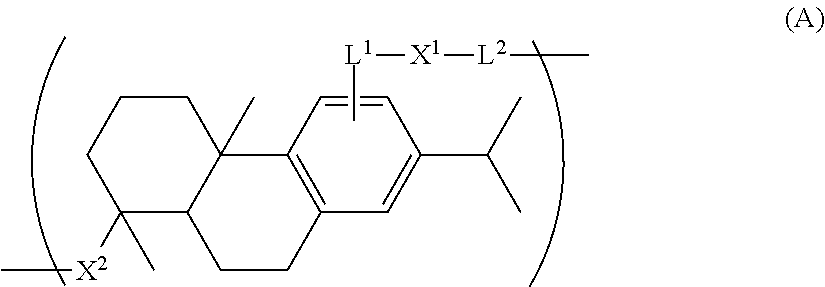Polymer derived from dehydroabietic acid and uses thereof
a technology of dehydroahietic acid and polymer, applied in the direction of instruments, optics, rosin adhesives, etc., can solve the problems of linear polymer having a high molecular weight, polymer is industrially disadvantageous, and does not meet the perspective of global environment protection
- Summary
- Abstract
- Description
- Claims
- Application Information
AI Technical Summary
Benefits of technology
Problems solved by technology
Method used
Image
Examples
synthesis example 1
[0229]
[0230]Sulfuric acid (30 ml) was added dropwise to acetic acid (100 ml) under ice cooling. Subsequently, dehydroabietic acid (manufactured by Arakawa Chemical industries, Ltd., 30.0 g) and para-formaldehyde (2.1 g) were added thereto at room temperature, and the mixture was stirred for 3 hours at 40° C. The reaction liquid was poured into 1 liter (l) of cold water, and the mixture was extracted with ethyl acetate. The extraction liquid was washed with water until the washing liquid became almost neutral, and dried over anhydrous magnesium sulfate. Subsequently, the solvent was distilled off under reduced pressure. 80 ml of methanol was added to the residue, and white crystals were collected by filtration and dried. Thus, DHA-1 (19.8 g) was obtained.
synthesis example 2
[0231]
[0232]Oxalyl chloride (13 g) was added dropwise at room temperature to a mixture of dehydroabietic acid (30.0 g) and methylene chloride (60 ml). After the mixture was stirred for 3 hours, the solvent was distilled oil under reduced pressure, and 16 g of methanol was added dropwise thereto. The mixture as stirred for 3 hours at room temperature, and then excess methanol was distilled of under reduced pressure. Thus an intermediate compound A (31 g) was obtained.
[0233]The intermediate compound A (31 g) and para-formaldehyde (2.1 g) were added to methylene chloride (150 ml), and sulfuric acid (50 ml) was added dropwise thereto at 10° C. to 15° C. After the dropwise addition, the mixture was stirred for 5 hours at room temperature, subsequently 500 ml of ice water was added thereto, in the organic layer was separated. The organic layer was washed with water until the washing liquid became neutral, and then dried over anhydrous magnesium sulfate, and methylene chloride was distille...
synthesis example 3
[0234]
[0235]Dehydroabietic acid (75 g) and succinic anhydride (38 g) were dissolved in methylene chloride (1 L), and anhydrous aluminum chloride (130 g) was added to the solution in small portions under ice cooling. The mixture was stirred for 2 hours at 10° C. to 15° C., and then the reaction liquid was poured into ice water. White crystals thus produced were collected by filtration, washed with water, and further washed with methanol. Thus, DHA-3 (72 g) as obtained.
PUM
| Property | Measurement | Unit |
|---|---|---|
| glass transition point | aaaaa | aaaaa |
| acid value | aaaaa | aaaaa |
| transition point | aaaaa | aaaaa |
Abstract
Description
Claims
Application Information
 Login to View More
Login to View More - R&D
- Intellectual Property
- Life Sciences
- Materials
- Tech Scout
- Unparalleled Data Quality
- Higher Quality Content
- 60% Fewer Hallucinations
Browse by: Latest US Patents, China's latest patents, Technical Efficacy Thesaurus, Application Domain, Technology Topic, Popular Technical Reports.
© 2025 PatSnap. All rights reserved.Legal|Privacy policy|Modern Slavery Act Transparency Statement|Sitemap|About US| Contact US: help@patsnap.com



